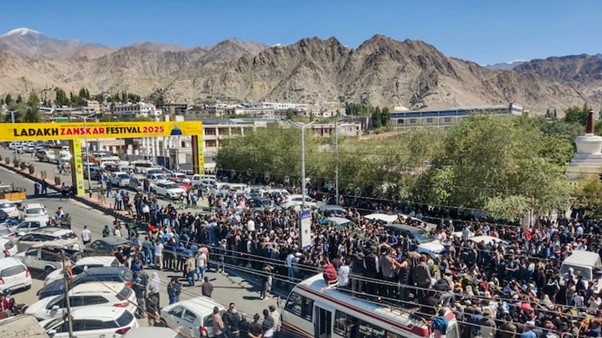Escalating Ladakh Unrest
The Union Territory of Ladakh is in turmoil following a surge of violent protests in Leh on 24 September 2025. The unrest, which has been simmering for weeks, culminated in widespread demonstrations, clashes with police, and the imposition of a curfew in central areas. The Ladakh unrest is driven by longstanding demands for statehood, inclusion under the Sixth Schedule of the Indian Constitution, and job and land protections for local residents.
At the centre of the crisis is noted climate activist Sonam Wangchuk, whose hunger strike since 10 September galvanized public support. His protest became a rallying point for the people of both Leh and Kargil, uniting them under the Leh Apex Body (LAB) and the Kargil Democratic Alliance (KDA). The two groups, historically divided, have come together in a rare show of solidarity, amplifying their demands for greater autonomy and constitutional safeguards.
Flashpoints and Violence
The situation deteriorated rapidly on 24 September when large groups of protesters attempted to march towards political offices. Demonstrators set fire to the BJP headquarters and the Hill Council office in Leh, leading to intense clashes with security forces.
- At least four people were killed in the violence.
- Over 80 individuals, including security personnel, were injured.
- More than 50 protesters were detained by authorities.
To contain the escalating Ladakh unrest, authorities imposed a curfew in Leh city starting at 1600 hours and invoked Section 163 of the Bharatiya Nagarik Suraksha Sanhita (BNSS), banning public gatherings of four or more people. The iconic Ladakh Festival’s closing ceremony was cancelled, underlining the severity of the disruption.
Background of the Crisis
The roots of the Ladakh unrest go back to 2019, when Ladakh was carved out as a separate Union Territory after the abrogation of Article 370. While the move initially raised hopes for more direct governance, local communities soon voiced concerns about political disempowerment, reduced representation, and vulnerability to outside interests in land, jobs, and natural resources.
The demands now focus on four core areas:
- Full statehood for Ladakh.
- Sixth Schedule inclusion, granting legislative and land safeguards similar to tribal areas in the northeast.
- Separate Lok Sabha constituencies for Leh and Kargil to ensure equal representation.
- Employment protections and reservation for local youth in government jobs.
The Impact
The Ladakh unrest has caused immediate disruptions across Leh and surrounding areas:
- Transport and Mobility: Roads in and around Leh have been blocked, with checkpoints established by security forces. Long-distance routes like the Srinagar–Leh highway remain tense, affecting goods supply.
- Tourism and Events: The cancellation of the Ladakh Festival dealt a blow to the tourism industry during its peak season. Several travel advisories have been issued, urging caution for domestic and foreign visitors.
- Business and Governance: Local government offices remain closed or are operating under strict restrictions, delaying administrative work, permits, and development projects.
- Public Safety: Residents face restrictions on movement, and essential services such as schools and markets have been temporarily shut down.
Recommendations
For Businesses and Institutions
- Enable remote work options and suspend non-essential travel to Leh until conditions stabilize.
- Review business continuity and crisis management plans, particularly for supply chains dependent on Srinagar–Leh and Manali–Leh routes.
- Enhance security protocols at offices, warehouses, and tourist properties.
For Residents and Travellers
- Avoid protest hotspots such as Martyrs’ Memorial Park, Potala Road, BJP headquarters, and central Leh.
- Carry valid identification and essential supplies during movement.
- Stay updated via official channels such as the Ladakh Police and the District Magistrate’s Office.
- Use alternative travel routes cautiously; avoid unverified local transport.
Outlook
The Ladakh unrest is both a political and social flashpoint. It symbolizes deep-rooted grievances about representation, autonomy, and cultural survival in a region critical for both India’s strategic security and environmental sustainability. With the 6 October meeting looming, the next two weeks will be crucial in determining whether dialogue can calm tensions or whether Ladakh slips into a prolonged cycle of agitation and state intervention.
For now, businesses, residents, and travellers must brace for continued disruptions, heavy security deployment, and an uncertain future in the high-altitude frontier of India.
Stay Ahead of Threats with datasurfr Predict
MitKat’s datasurfr delivers accurate, real-time, and contextualised data to help organisations respond swiftly to physical, environmental, and cyber threats.
With datasurfr Predict, our AI Agent not only provides context for unfolding events but also analyses vetted historical data to forecast how events are likely to evolve and their potential impact using industry and location-specific probabilistic scores. Book a free demo today and see how datasurfr Predict can transform your risk preparedness.


